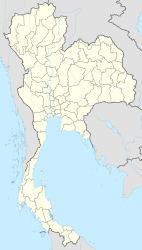Si Satchanalai
|
เทศบาล เมือง ศรีสัชนาลัย Si Satchanalai |
||
|---|---|---|
|
|
||
| Coordinates | 17 ° 31 ' N , 99 ° 46' E | |
| Basic data | ||
| Country | Thailand | |
| Sukhothai | ||
| ISO 3166-2 | TH-64 | |
| Website | www.sisatcity.go.th | |
Si Satchanalai ( Thai : เทศบาล เมือง ศรีสัชนาลัย ) is a city ( Thesaban Mueang ) in the district ( Amphoe ) Si Satchanalai , Sukhothai Province in the northern region of Thailand . Si Satchanalai is also the capital of Si Satchanalai County.
location
The city is located about 50 kilometers north of the provincial capital Sukhothai in a scenic location on the Mae Nam Yom (Yom River).
Neighboring municipalities and cities:
- North: Tambon Nong O, Si Satchanalai District, Sukhothai Province.
- East: Pa Kum Ko Town, Sawankhalok Amphoe , Sukhothai Province.
- South: Tambon Tha Chai, Si Satchanalai Amphoe, Sukhothai Province.
- West: Tambon San Chit, Si Satchanalai District, Sukhothai Province.
history
Si Satchanalai was founded around 1250 as the second residential city of the Sukhothai Empire , in which the Uparat ("second king" and designated heir to the throne) resided. It is here that the future King Li Thai is said to have written the first great work of Thai literature, the Traiphum Phra Ruang , in 1340 when he was still Uparat .
The city was laid out in a rectangular shape and in the 16th century was given a five-meter-high wall with a water ditch in front of it to defend itself against the increasing Burmese attacks . The location of the city was favored by two hills dominating the area. Far beyond the borders of the country, they became famous for his until the 16th century operated by 13 ceramic repairers whose products (particularly Seladonware ) as far as Indonesia , the Philippines , to Borneo and the Ryukyu Islands in Japan were exported . The kilns now unused are about five kilometers long on the banks of the Yom, from Ban Pa Yang outside the old city wall to Ban Ko Noi in the north, where the largest collection of kilns is located.
During the Ayutthaya period , Si Satchanalai was renamed Sawankhalok . The name Sawankhalok or Sangkhalok ceramics therefore refers to Si Satchanalai and not to the city and county that today bear this name.
Finally, Si Satchanalai was captured and destroyed by the Burmese army in the 18th century. The residents were relocated to (today's) Sawankhalok , around 20 kilometers further south, and the name moved with the residents. The fields of ruins in the old Si Satchanalai have been restored since 1990, initially the city wall, the royal palace and Wat Chang Lom.
Attractions
Individual evidence
- ↑ Glen R. Brown, "Thai Stoneware of the 14th to the 16th Centuries". Ceramics Technical , 2008, No. 26, pp. 21-26.
literature
- AB Griswold : Towards A History Of Sukhothai Art . The Fine Arts Department , Bangkok 1967.
- John N. Miksic (Ed.): Southeast Asian Ceramics. New Light on Old Pottery. Southeast Asian Ceramic Society, Singapore 2009.


